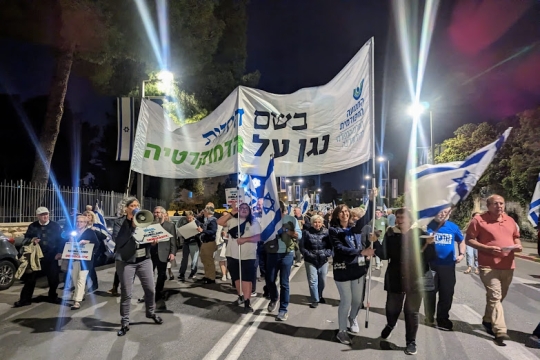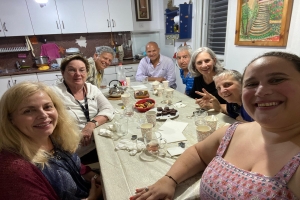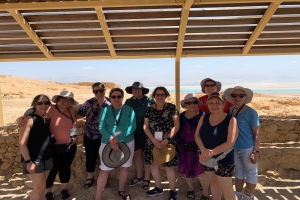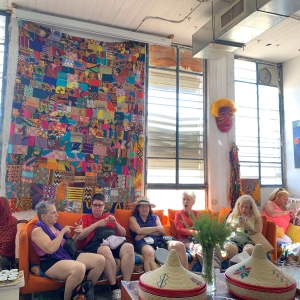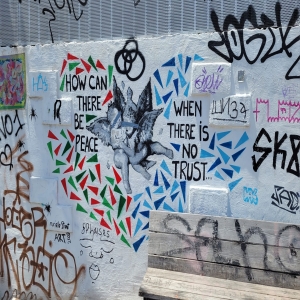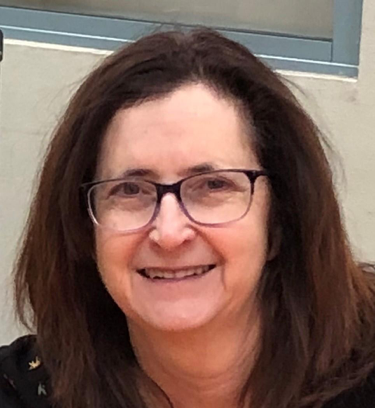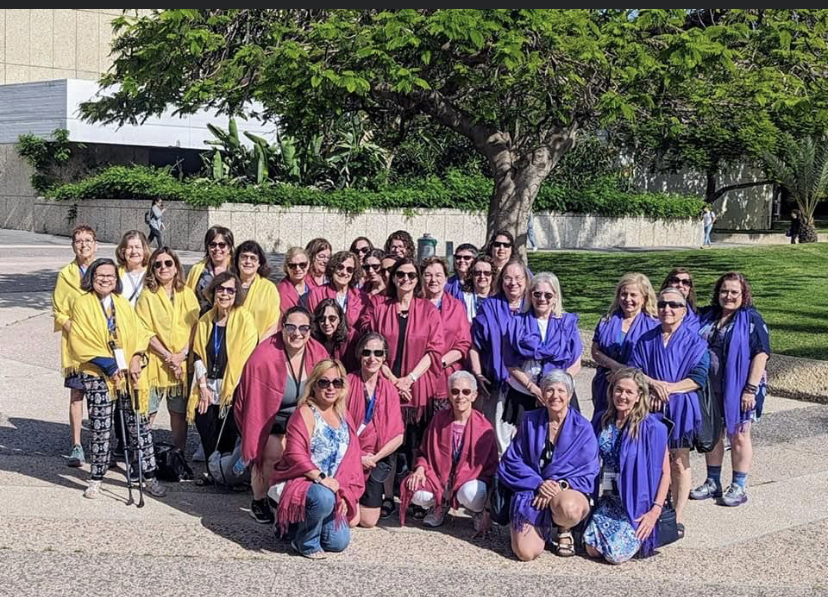
Last week, several WRJ women finished up their tour of Israel on WRJ's “Women Off the Beaten Path” journey. They have been sending photos and stories about their adventures all week, and we have been posting them on social media. Here is a complete recap of the last few days of the trip. Thanks to everyone on the trip for sending photos and writing blogs and to WRJ Director of Philanthropy, Shari Schulner, for sending daily recaps. All trip photos can be found on WRJ's Facebook page.
On Friday
We left Galilee and stopped at Caesarea, one of the Land of Israel's most important cities during the Roman and Crusader periods, with many structures built by Herod beginning in 375 CE. We had lunch in the Caesarea Port and enjoyed some retail therapy before continuing to Tel Aviv, also known as “the city that never sleeps.”
After checking into the beachside Sheraton, we joined Kabbalat Shabbat services at a newly built synagogue of an already existing community, Shoham Reform Congregation. Services were led by Rabbi Rinat Tzfania-Schwartz. The singing was beautiful, the discussions powerful, and it was so meaningful to bring Shabbat in with this special group. From there, we split up and went to different households for Shabbat dinner in the community. There was a variety of the country’s influences in each Shabbat meal. One household served a vegetarian meal with eggplant prepared in various ways. Another home served Yemenite and Iraqi food. Everyone agreed that this was a night to remember and exchanged contact information to keep in touch with their home hospitality group.
Saturday
Some of the group woke up early to travel to Masada. WE toured and learned about how it was built, and its incredible water system, and then took in views of the Dead Sea. Masada, a UNESCO World Heritage Site, is where Jewish rebels are believed to have made their final attempt to resist Roman invaders (74 CE). Herod built a palace atop Masada, and it is slowly being excavated. A black line on the stone wall indicates what is original (below the line) and the reconstruction above it.
The group then went to the Dead Sea and enjoyed the healing, salty, and of course, floating elements of the lowest body of water on Earth. The group that remained in Tel Aviv took a tour of the city, learning about its history, the role of women in the development of Tel Aviv, and the historic sites that shaped Israel's history. Much of the group gathered for dinner on the beach and Havdalah with our partners at IMPJ.
Sunday
We began with a photo stop in Jaffa, where on May 14, 1948 - 75 years ago- David Ben-Gurion declared Israel’s independence. The declaration had 37 signatures, only two of which were women - Golda Meir and Rachel Cohen-Kagan. Our tour guide showed us the Myay 15, 1948 edition of The New York Times, which declared,” Zionists Proclaim New State of Israel”. The U.S. recognized the new state while Egypt and other neighboring countries declared war, and bombs fell on Tel Aviv.
After admiring the views in Jaffa, we headed to Kuchinate in Southern Tel Aviv. This organization, whose name means “crochet” in Tigrinya, was founded in 2011 as a women’s-only organization to help women arriving from Egypt who were not receiving government help.
They helped single mothers, trafficking survivors and supported more than 350 women seeking asylum. The organization provides psychosocial support, economic empowerment (thru learning new handcrafting skills), advocacy, and education of the community as well as classes for the women and their families.
We met with the women from East Africa for a traditional coffee-making ceremony and talked with them about their lives in Israel and the struggles they are seeking to overcome through creativity and collective action.
We continued on to learn about the great thinkers and founders of Tel Aviv, the first Zionist city, who are buried at Trumpeldor Cemetery, including Israel’s “National Poet” Haim Bialik. Ahad Ha’Am and Tel Aviv’s influential first mayor Meir Dizengoff. We also heard the voices of their wives, along with the famous singer Shoshana Damari, the author Devorah Barron, and the sister of the poet Rachel.
Finally, we visited KitePride, an Israeli fashion social enterprise owned by an Israeli NGO which provides jobs to survivors of human trafficking and prostitution. They create functional, one-of-a-kind bags from up-cycled kitesurfing kites, sails, parachutes, and wetsuits. Through each bag sold, jobs are created, and the fabric is saved from landfill. KitePride’s employees are also human trafficking survivors. The business was created to teach job skills, life skills, and job placement with friendly employers. According to co-founder Tabea Oppliger, there are 14,000 individuals in Israel being trafficked who, on average, are 13-14 years old.
Monday
We checked out the new ANU: Museum of the Jewish People after a group photo with our WRJ colors. Many interesting exhibits, from “Being Jewish Today” to “Who is Jewish,” in every endeavor. After the museum, we explored the Urban Art Scene of Southern Tel Aviv in the blue-collar neighborhood of Kiryat HaMelacha. It has suddenly become the happening home of contemporary Israeli art. A local art expert guided us through the neighborhood’s galleries and studios, where we saw a variety of work by artists working in sculpting, ceramics, exploring wood, and digital photography of real objects, which are then manipulated and viewed some of the street art. We returned to the hotel for packing and finished the evening with a wonderful dinner and said goodbye to those who were heading home that night and talked about further adventures.
Thanks for following our adventures on the WRJ blog and our Facebook page. Please check out our photo album for more of our experience, and feel free to tag yourselves in the album.
Related Posts
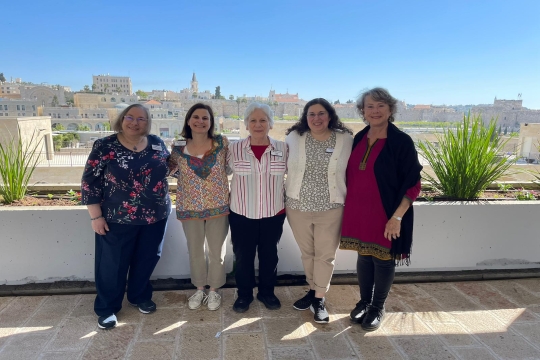
Connecting with Women from Around the World
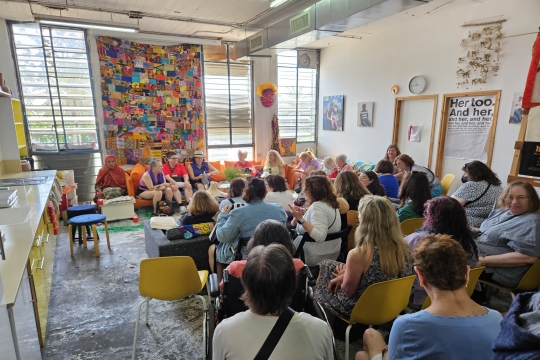
Learning & Traveling with WRJ
